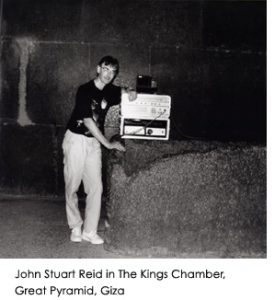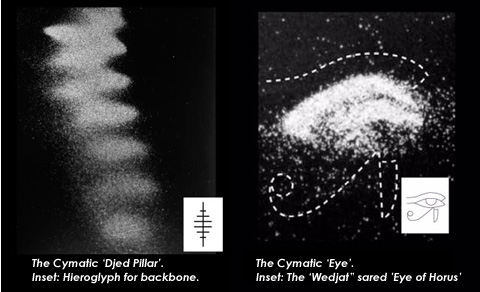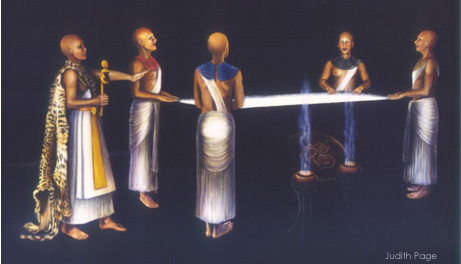The ancient Egyptians laid the foundations of many sciences and some of their discoveries influenced Greek and Roman science. In the field of acoustics we know from the Roman architect, Vetruvius, that acoustic techniques were employed in both the Roman and Greek cultures; but were their architects inspired by acoustical knowledge obtained from ancient Egypt?
Few who have experienced the acoustics of the Great Pyramid’s King’s Chamber have not walked away with a feeling of awe, in some cases coupled with an impression that the chamber was designed to be reverberative.
For a relatively small chamber the reverberation is indeed extraordinary; one can literally hear one’s own breathing (when the fluorescent lighting is turned off!) and this experience often accompanies feelings of cathedral-like reverence. This notion of design implies a prior knowledge of acoustics and materials science.
The high levels of reverberation in the chamber are actually a function of the flat granite surfaces, their parallel arrangement and the chamber’s dimensions. Let us discuss the likelihood of acoustics design.

The earliest evidence of granite working in ancient Egypt dates to 3,900 BC at Nekhen, 1400 years before the Great Pyramid was built (around 2,500 B.C.) a long period in which an acoustics science could have been acquired by the ancient Egyptian engineers. However, an obvious question to ask is what would have driven their need to control the acoustics environment? The answer, almost certainly, relates to their desire to communicate with the spirit world during their sacred ceremonies
The following quotation from Demetrius, circa 200 B.C., from ‘Aristotle, Poetics’ suggests that purity of sound was important in his era:
‘In Egypt, when priests sing hymns to the gods, they sing the seven vowels in due succession and the sound of these vowels has such euphony that men listen to it instead of the flute and the lyre.’
Such ”euphony” would, no doubt, have been enhanced by singing in reverberative chambers, just as reverberation plays an important function in churches today, to enhance one’s sense of connection with spirit and to optimize the choir and organ performance. Although the date of this quotation is much later than the pyramid age it should be remembered that vowels were considered sacred throughout ancient Egyptian history and that Late Period customs invariably had their roots in early or even pre-dynastic times. It seems reasonable to suggest, therefore, that the ancient Egyptians of the 4th dynasty, when the Great Pyramid was built, used vowel sound chant as part of their ritual. However, even if their chant was not specifically vowel sound oriented, studies of ancient Egyptian cult texts of a religious character, by Waltraud Gugliemi, have revealed that, in many cases, they were intended to be sung rather than spoken. (The journal of: ‘Ancient Egyptian Literature’) Singing in enclosed spaces is always enhanced by reverberation.
Dr. Lise Manniche, in her book ”Music & Musicians in Ancient Egypt” provides confirmation of singing in relation to pyramids with the following quotation from Nikaure of the 5th dynasty.
‘Instructor of the singers of the Pyramid of King Userkaf’
This title, given to Nikaure, seems to indicate that a group of singers were retained specifically to maintain song or chant-based rituals at the pyramid of Userkaf, although whether the singers performed inside or outside the pyramid cannot be determined.
Although I did not carry out a Critical Distance Test in the King’s Chamber (the distance from a given sound source at which the level of direct energy, reaching one’s ears, equals the level of reflected energy) those readers who have visited the Great Pyramid will know that even when two people are as close as one metre apart, speech intelligibility is extremely poor in the King’s Chamber. However, this effect works very much in favor of chanting or singing, where continuity not intelligibility, is the prime concern. This is particularly relevant where extended vowel sounds are employed, for example, in Gregorian Chant.
Now consider the following extract from the ancient Egyptian Book of the Dead, translated by R.O. Faulkner in his book entitled ”The Book of the Dead.”
”The Mighty One appears, the horizon shines. Atum appears on the smell of his censing, the Sunshine- god has risen in the sky, the Mansion of the pyramidion is in joy and all its inmates are assembled, a voice calls out within the shrine, shouting reverberates around the Netherworld.”
(Emboldened words are my emphasis) Spell 133
One could interpret this spell as being suggestive of a ritual performed within a pyramid in which vocally generated sound played an important part, though further research is needed in which a corpus of ancient Egyptian texts is examined and interpretation of the transliterations is made.
R.A. Schwaller de Lubicz in his book, ‘Sacred Science’ also believed that the ancient Egyptians used sounds, as distinct from words, in their rituals. In the last sentence of the following passage he quotes from Corpus Hermeticum:
”Sacred or magical language is not to be understood as a succession of terms with definite meanings…the excitation of certain nervous centres [cause] physiological effects [which] are evoked by the utterance of certain letters or words which make no sense in themselves.”
”The Pharaonic texts are rich in examples of litanies playing a magical role through the repetition of sounds…and through word play. The hieroglyphic writings allow us to confirm this although their transcription into our language is impossible since the pronunciation of this language is unknown…In a letter from Asklepios to King Amman[he says]:
”As for us, we do not use simple words but soundsall filled with power.”
(Emboldened words represent the Corpus Hermeticum reference)
The acoustics study of the Great Pyramid was undertaken in order to investigate my hypothesis that (a) the King’s Chamber was designed to be highly reverberative and (b) the chamber and its sarcophagus are acoustically coupled, that is, the energy of any sound made in the chamber is largely transferred into the sarcophagus. Such coupling was, I postulate, designed to support a rebirthing ritual enacted prior to the pharaoh’s death or perhaps after his death.
The King’s Chamber sarcophagus is highly resonant, partly due to its high quartz content, hence the Egyptian architect’s choice of raw material since limestone and alabaster lack the resonant properties enjoyed by granite. I am of the opinion that vowel sound chant in the acoustically enhanced King’s Chamber was intended to have an energizing effect on the sarcophagus during sacred rituals. A clue as to what such rituals may have involved is given by Professor I.E.S. Edwards in his book ‘The Pyramids of Egypt.’
‘According to one of the most popular myths . . . the sun-god Re entered the mouth of the sky goddess Nut every evening, passed through her body and was reborn at dawn. When he died, the King was assimilated to Re and was thought to undergo the same nightly process of gestation and rebirth as the sun god.
Spell 430 addresses the god in the womb thus: ‘You are restless, moving about in your mother’s womb in her name of Nut.’ It is particularly indicative that Djedefre, Cheops’ immediate successor, should have chosen to have an oval, not rectangular, sarcophagus; it is really a representation of the human womb . . . As these texts show, the actual sarcophagus was regarded as identical with Nut and it possessed her maternal attributes.’
If Cheops’ sarcophagus symbolized the womb of Nut, it is reasonable to conjecture that it may have been used as part of their ‘rebirth rituals prior to the pyramid being finally sealed. Noting that the sarcophagus rings like a bell when struck, (albeit at a low frequency) I considered the possibility that the architect had engineered it to resonate at the pitch of sound (as distinct from the rate of beat) of a baby heart since rebirth rituals were concerned with the gestation of a fetus and the birth of new life.
This concept is consistent with Professor Edwards’ hypothesis of the sarcophagus as a womb and it is further strengthened by the discovery of a pesh-en-kef instrument that was discovered in the pyramid by Englishman, Wayman Dixon. This instrument was used to sever the umbilical cord of newborn babies; fashioned from flint in archaic times it consisted of two curved blades that met at a point and would be circumflexed around the umbilical, in effect an early form of scissors. The version discovered in the pyramid was made in bronze and was a symbolic representation of a pesh-en-kef, not a working instrument, hence the blades were not sharpened.
It is thus possible that the ancient Egyptians considered the sarcophagus as the ‘seed of Nut,’ the King’s chamber as her ‘womb’ and the twin star shafts as her ‘fallopian tubes.’ In this respect it is interesting to note that the twin star shafts of the Queen’s Chamber were not originally cut through into the chamber but concealed 4-inches behind the limestone wall surface (the pesh-en-kef was found in the northern shaft.) If a similar sonic ritual was conducted in the Queen’s Chamber the reason for their concealment becomes clear: In the human female the isthmus of the fallopian tube (the point where it enters the womb) opens only once per month to allow the passage of the seed in its transit from the ovaries. It then closes and remains closed until the next monthly cycle. Concealment of the opening of the ‘fallopian tubes’ may have been a symbolic reference to the monthly cycle of Nut.
Cymatics Experiment
I conceived and conducted the cymatics experiment, in 1997, as a method of making visible the acoustic resonances and eddies occurring within the sarcophagus when excited by an oscillator and powered speaker arrangement, thus mimicking the vowel sound chant of priests. In so doing it was hoped that the acoustic coupling mechanism could be better understood.
The north west corner of the sarcophagus is badly damaged and in order to stretch the p.v.c. membrane over its open top and maintain a level surface, it was necessary to ”repair” the broken corner and to level the top edges that are largely broken away. This was achieved by means of expanded polystyrene sheets / adhesive tape and a pre-prepared aluminium right angle for repair of the corner. The membrane was then stretched over the sarcophagus and weighted around its perimeter with 43 bags of sand, of approximately 1Kg each, to produce an even torsion across its surface. (Each bag was filled with 1 plastic beaker volume of sand.) The speaker had been positioned centrally inside the sarcophagus and connected to the oscillator. Finally, a fine sprinkling of quartz sand was applied to the entire surface area of the membrane and the oscillator turned on, commencing at 20 KHz and slowly sweeping down the band whilst closely observing the sand grains for movement.
The graphic equalizer was not used to flatten the speaker’s response since the visual effects are as much a function of excitation level as they are of frequency and where a given frequency and sound pressure level can sometimes produce intricate images in the sand grains, such images may not occur at all if the level of acoustic energy is insufficient.
As each resonant picture emerged, the frequency was recorded and a monochrome photograph taken.
The experiment produced a rich and extremely varied set of cymatic pictures, far exceeding in complexity any previously seen during control tests in my laboratory. (Control tests were carried out prior to the research mission in a sarcophagus of identical dimensions but constructed in timber. The most complex image obtained was a simple set of longitudinal striations.)
Many of the images showed odd striation arcs, presumed to be evidence of high local static charge created as a consequence of exciting the quartz crystal content of the granite.
While several images lent the appearance of organic matter or coral seas the strangest resembled ancient Egyptian hieroglyphs. How these figures came to be locked in the granite is, perhaps, easily explained, as follows.

The interaction between the acoustic field, the resonance of the quartz particles embedded in the granite and the inherent resonances of the quartz sand grains is an immensely complex one. However, the patterns that form are essentially harmonic and in studying the hieroglyphic-like cymatic forms I was persuaded that these too are essentially harmonic, the result of naturally occurring geometries within the crystals released during acoustic excitation of the sarcophagus. Consider that during the fashioning of granite in a craftsmen’s workshop the stone would ring like a bell with every strike of the hammer. The resulting sound field patterns would radiate away and manifest (invisibly) on all the membranes of the worker’s bodies, their skin, eyes and on every cell. It seems possible that scribe-priests would have been present during at least some of the work, perhaps to check on progress, and they too would have been influenced, albeit subliminally. It may not be a coincidence, then, that the earliest evidence of granite working in Egypt (circa 3,900 BCE) occurred at around the same time that Egyptologists date the emergence of hieroglyphic writing, both are thought to have occurred at ancient Nekhen. It seems easily possible, therefore, that the birth of the Egyptian written language and their working of granite are inextricably linked.
Finally, I wish to leave the reader with an illustration of the ‘Sonic Rebirth Ritual’ envisioned with the help of the talented artist Judith Page. In this hypothetical ritual the sarcophagus contains the pharaoh Cheops (either living or dead). The four priests, standing at each corner, gently rest their fingertips on the granite edge in order to sense the resonant frequency. The priests generate powerful vowel intonations, gradually shifting the pitch until maximum acoustic excitation occurs. At this point, two of the priests maintain this frequency whilst the other two drop their pitch by a small margin, thus creating dramatic beat frequencies. Meanwhile the Sem priest, robed in a beautiful leopard skin, continually recites magical spells and confers these upon the pharaoh by holding his left hand over the sarcophagus. Cheops’ ka travels to the stars, via the star shafts, and returns to be reborn, illustrated by the image of a fetus.

If you have enjoyed this article my Egyptian Sonics book is available, containing details of many other experiments in the Great Pyramid and many more illustrations. Please visit our cymatics shop. All purchases help to fund further cymatics research.









